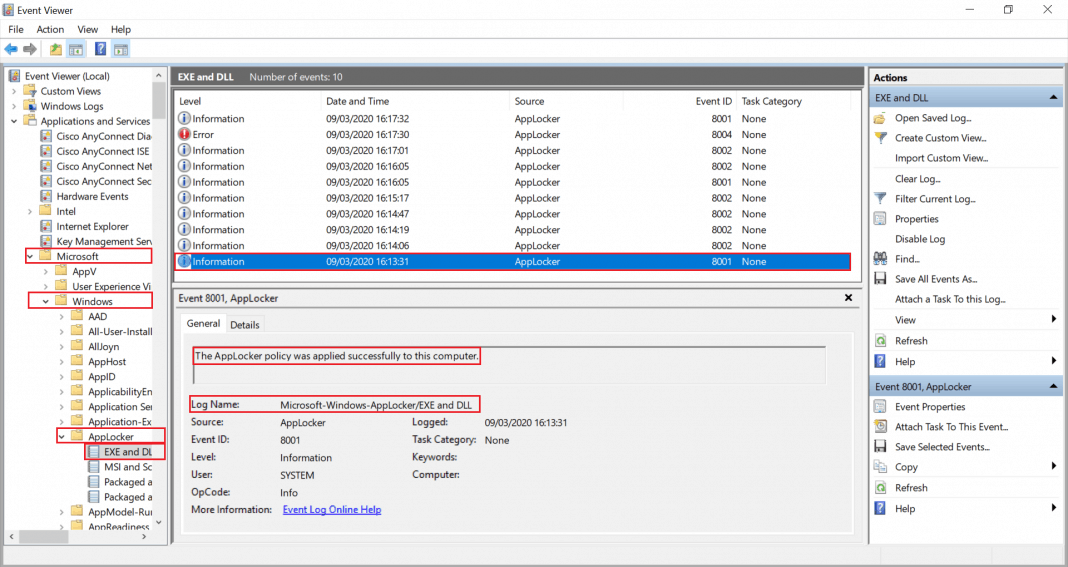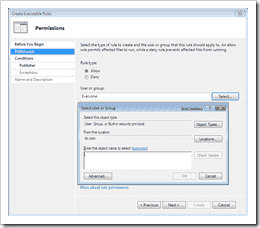
- #MICROSOFT APPLOCKER WINDOWS 10#
- #MICROSOFT APPLOCKER SOFTWARE#
- #MICROSOFT APPLOCKER WINDOWS#
Wait the GPO refresh (30 minutes on domain members, 5 minutes on domain controller) or run gpupdate. Assign a rule to a security group or an individual user.
#MICROSOFT APPLOCKER SOFTWARE#
Microsoft AppLocker software is an easy to.
#MICROSOFT APPLOCKER WINDOWS#
You can also create rules based on the file path and hash. McAfee Application Control is also compatible with some of the Windows Embedded operating system key features. Tick Configured in Packaged app Rules section > Enforce rules: AppLocker can help you: Define rules based on file attributes that persist across app updates, such as the publisher name (derived from the digital signature), product name, file name, and file version. If you want to restrict applications on other user account, we could add those applications to registry HKEYCURRENTUSER\SOFTWARE\Microsoft\Windows\CurrentVersion\Policies\Explorer\DisallowRun.
#MICROSOFT APPLOCKER WINDOWS 10#
It simply fails with a '516' status, which is 'atomic operation was rolled back', although I am not attempting an atomic operation. Hi Sergey, You can only manage AppLocker with Group Policy on devices running Windows 10 Enterprise, Windows 10 Education. Therefore, if you are not logged on, you are not affected. However, it only works if the user is logged on.

It is an excellent alternative to removing the app and its associated data from the system.
Allow members of the Everyone group to run apps that are located in the Program Files folderįinally, right click on AppLocker > Properties. I've attempted a number of variations on the XML that can be exported from the Group Policy editor for AppLocker, but cannot get Windows to accept any of the XML. Microsoft AppLocker is a security policy that prevents the user from starting apps. Allow members of the Everyone group to run apps that are located in the Windows folder. Allow members of the local Administrators group to run all apps. Open Group Policy Management Editor, modify concerned GPO’s settings go to Computer configuration > Application Control Policies > Applocker > right click on Executable Rules (or Packaged app Rules) > Create Default Rules: Then, if you have these events, you need to change the GPO related to Applocker.In fact, you have to create the default rules. Of course, you can use PowerShell to detect these Event ID: Get-WinEvent -LogName "Microsoft-Windows-AppLocker/Packaged App-Execution" | Where-Object Create Applocker Default Rules To do that, You can check the Event ID 8026 or 8027 in the Event Viewer ( Applications and Services Logs > Microsoft > Windows > AppLocker > Packaged App-Execution). If it does, check if you have any GPO which enables AppLocker executable rule. If Applocker is misconfigured, it could lead to problem on the computer, for example blocks the Windows start menu.įirst, check if your computer belongs to a domain or not. These include executable files, scripts, Windows Installer files, dynamic-link libraries (DLLs), packaged apps, and packaged app installers. ApplockerĪppLocker helps you control which apps and files users can run. I am attempting a simple replace, using a locuri such as "./Vendor/MSFT/AppLocker/ApplicationLaunchRestrictions/TEST_GUID/EXE/Policy".Nothing happens when you click on the Windows logo? Neither when you use the Windows key on your keyboard? The right click on Windows logo launches a menu? Well, your lock is problably due to the Applocker. It simply fails with a "516" status, which is "atomic operation was rolled back",Īlthough I am not attempting an atomic operation. I've attempted a number of variations on the XML that can be exported from the Group Policy editor for AppLocker, but cannot get Windows to accept any of the XML. I've been able to successfully create Policy nodes, but only with empty XML values, which is of course useless to anyone. A specific working example would be ideal. (see screenshot below) This command is to make sure the Application Identity service is enabled, set to Automatic, and running. 2 Copy and paste the command below into the elevated command prompt, press Enter, and close the elevated command prompt when it has finished. The issue is, there is a lack of description for what this XML should actually look like. Here's How: 1 Open an elevated command prompt. 
When dealing with the ApplicationLaunchRestrictions nodes, it seems that for each policy node, we are expected to provide an XML blob that describes the ruleset in question. I've been attempting to use the AppLocker CSP documented here:






 0 kommentar(er)
0 kommentar(er)
